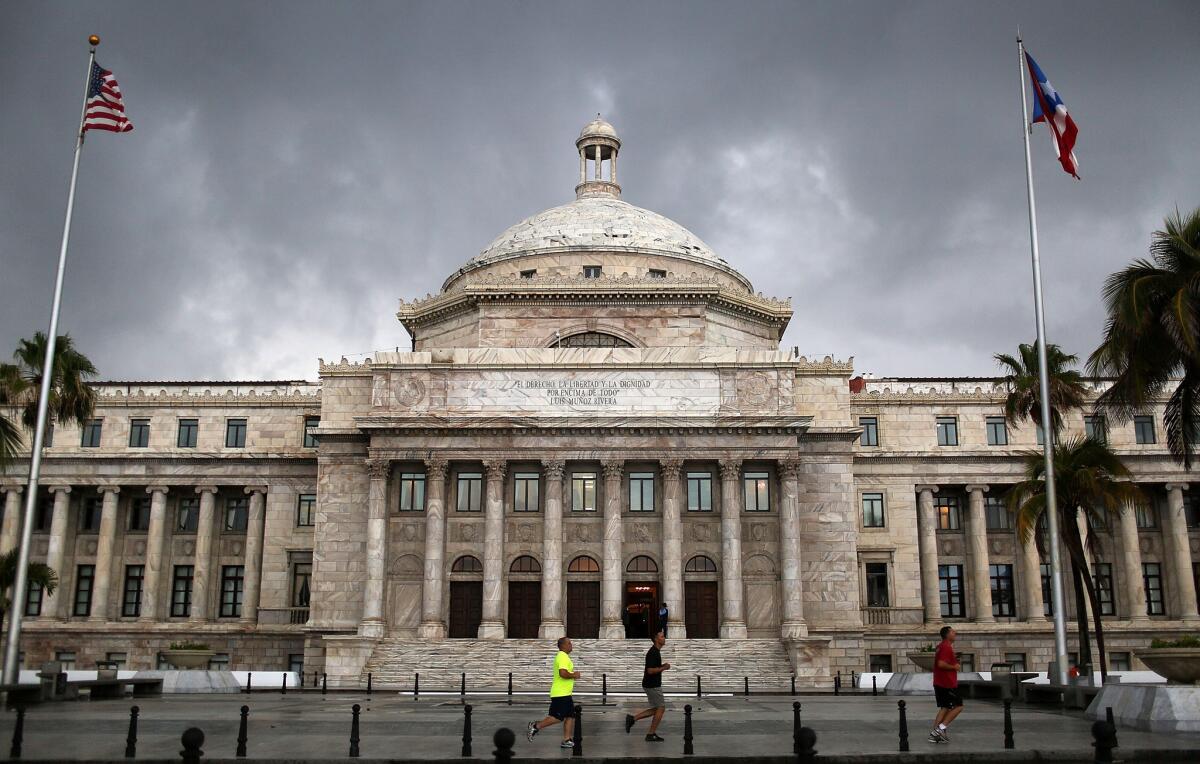Editorial:: How to handle Puerto Rico’s debt crisis

The Puerto Rican Capitol building in San Juan is seen on July 1, as the island’s residents deal with the government’s $72 billion debt.
- Share via
This has not been the best week for risky government securities. First, the Greek government failed to make a $1.7-billion payment that was due Tuesday. Then the Puerto Rican government revealed that its debt had become unsustainable, although it managed to forestall a default by making more than $1 billion in payments Wednesday. The coincidental timing aside, the situations in Puerto Rico and Greece are only superficially similar. Still, the latter’s prolonged troubles and repeated rounds of brinkmanship offer Puerto Rico’s creditors a lesson in how not to handle a debt crisis.
Both Puerto Rico and Greece got into trouble by borrowing money to run large budget deficits to sustain excessive government payrolls and programs. But the Caribbean commonwealth, which is a U.S. territory, can also blame U.S. policymakers for exacerbating its problems by terminating a federal tax break that had drawn manufacturers to the island. Congress also set comparatively high levels for Puerto Rico’s public assistance payments, which along with the vigorous underground economy helps explain why less than half of its adults are in the workforce, compared with nearly two-thirds in the United States. Meanwhile, thousands of the most educated and talented workers have decamped to the United States in search of better opportunities.
That’s not to argue for a taxpayer bailout or to absolve Puerto Rican leaders. Although successive administrations took numerous steps to try to close the budget gap, they didn’t go far enough to put the government on a sustainable footing. Nor did they ever stop borrowing. Puerto Rico’s debt is now so large — about $72 billion, far more per resident than any state has amassed — that it has become trapped in a “vicious circle” of ever-worsening fiscal problems, three current or former International Monetary Fund economists wrote in a new report.
The island’s government must do more to rein in spending and to bring more adults back into the workforce, difficult tasks that will require some help from Congress. So, too, should Congress give commonwealth-owned enterprises the same access to bankruptcy courts that their U.S. counterparts have, enabling a more fair and orderly resolution of the debts they can’t pay. Ultimately, though, the hedge funds and mutual funds that bought Puerto Rico’s tax-free bonds will have to support the government’s effort to reignite the economy. That means dropping their opposition to the needed change in bankruptcy law, accepting some losses and helping the government develop a restructuring plan that emphasizes growth in addition to responsibility.
The turmoil in Greece over the last five years illustrates what happens when creditors demand reforms but ignore their effect on a struggling economy. For their own sake as well as for the island’s, Puerto Rico’s bondholders should learn from that mistake.
Follow the Opinion section on Twitter @latimesopinion and Facebook
More to Read
A cure for the common opinion
Get thought-provoking perspectives with our weekly newsletter.
You may occasionally receive promotional content from the Los Angeles Times.









